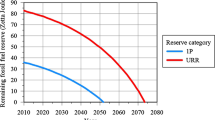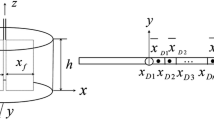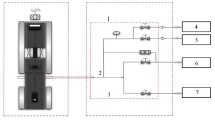Abstract
This article presents the PTA on the multi-stage fractured horizontal well in shale gas reservoirs incorporating desorption and diffusive flow in the matrix. Currently, most PTA models are simply based on Darcy flow both in natural fractures and matrix without considering the mechanisms of desorption and diffusion in shale matrix. Source function and Laplace transform with the numerical discrete method are employed to solve the mathematical model. The solution is presented in the Laplace domain so that the wellbore storage effect and skin factor can be easily incorporated by convolution. Type curves are plotted with Stehfest algorithm and different flow regimes are identified. The presented model could be used to interpret pressure signals more accurately for shale gas reservoirs.
Similar content being viewed by others
Abbreviations
- B gi :
-
Volume factor under initial condition, dimensionless
- C :
-
Wellbore storage coefficient (m3/Pa)
- c g :
-
Gas compressibility (Pa−1)
- C L :
-
Langmuir constant (sm3/m3)
- C m :
-
Volumetric gas concentration in the matrix in transient diffusion, (sm3/m3)
- C m :
-
Initial volumetric gas concentration in the matrix in transient diffusion (sm3/m3)
- D :
-
Diffusion coefficient (m2/s)
- h :
-
Reservoir thickness (m)
- (i, j):
-
The jth discrete segment of the ith fracture
- (k, v):
-
The vth discrete segment of the kth fracture
- k fh :
-
Horizontal permeability of natural fracture (m2)
- k fv :
-
Vertical permeability of natural fracture (m2)
- K 0():
-
Modified Bessel function of second kind of order zero
- L :
-
Characteristic length (m)
- L fLi , L fRi :
-
Lengths of the left and right wings of the ith fracture (m)
- m :
-
Number of hydraulic fractures
- n :
-
Number of segments on the wing of each fracture
- p 0 :
-
Reference pressure (Pa)
- p i :
-
Initial reservoir pressure (Pa)
- p sc :
-
Standard state pressure (Pa)
- \({\tilde{q}}\) :
-
Production rate from continuous point source (m3/s)
- \({\tilde{q}_{\rm l}}\) :
-
Flux per unit length (m2/s)
- \({\tilde{q}_{{\rm l}i,j}}\) :
-
Flux per unit length of discrete segment (i, j), (m2/s)
- q sc :
-
Production rate at surface conditions, (m3/s)
- r :
-
Radial distance in natural fracture system (m)
- R :
-
External radius of matrix block (m)
- r m :
-
Radial distance in matrix system (m)
- S f :
-
Fracture skin factor, dimensionless
- t :
-
Time (s)
- T :
-
Reservoir temperature (K)
- T sc :
-
Standard state temperature (K)
- u :
-
Laplace transform parameter, dimensionless
- V :
-
Average volumetric gas concentration in the fracture (sm3/m3)
- V E :
-
Equilibrium volumetric gas concentration in pseudo-steady diffusion (sm3/m3)
- V i :
-
Initial volumetric gas concentration in the fracture (sm3/m3)
- x, y, z :
-
Space coordinates in Cartesian coordinates (m)
- x i,j , y i,j :
-
Coordinates of endpoint of discrete segment (i, j) (m)
- x mi,j , y mi,j :
-
Coordinates of midpoint of discrete segment (i, j) (m)
- x mk,v , y mk,v :
-
Coordinates of midpoint of discrete segment (k, v) (m)
- x w, y w, z w :
-
Space coordinates of continuous point source (m)
- Z :
-
Real-gas compressibility factor, dimensionless
- Z i :
-
Real-gas compressibility factor under the initial condition, dimensionless
- α :
-
Adsorption index, dimensionless
- λ :
-
Inter-porosity flow coefficient, dimensionless
- ω :
-
Storativity ratio, dimensionless
- τ :
-
Sorption time constant (s)
- ξ :
-
Integration variable
- μ :
-
Gas viscosity, (Pa · s)
- μ i :
-
Initial gas viscosity, (Pa · s)
- \({\phi_{\rm f}}\) :
-
Natural fracture porosity, fraction
- ψ :
-
Pseudo-pressure (Pa)
- ψ i :
-
Initial pseudo-pressure (Pa)
- ψ L :
-
Langmuir constant (Pa)
- ψ w :
-
Wellbore pseudo-pressure (Pa)
- Δψ s :
-
Additional pseudo-pressure drop caused by formation damage (Pa)
- Δx i,j :
-
= x i,j+1 −x i,j
- ΔL :
-
Hydraulic fracture spacing (m)
- — :
-
Laplace domain
- D:
-
Dimensionless
- f:
-
Natural fracture
- i :
-
Initial condition
- m:
-
Matrix
- sc:
-
Standard state
- w:
-
Wellbore
References
Al-Kobaisi, M., Ozkan, E., Kazemi, H.: A hybrid numerical/analytical model of a finite-conductivity vertical fracture intercepted by a horizontal well. SPERE&E 24(10), 345–355 (2006). doi:10.2118/92040-PA. SPE-92040-PA
Brown, M., Ozkan, E., Raghavan, R., Kazemi, H.: Practical solutions for pressure transient responses of fractured horizontal wells in unconventional reservoirs. Paper SPE 125043 presented at the SPE Annual Technical Conference and Exhibition, New Orleans, Louisiana, 4–7 October 2009. doi:10.2118/125043-MS
Cheng, Y.M.: Pressure Transient Characteristics of Hydraulically Fractured Horizontal Shale Gas Wells. Paper SPE 149311 presented at the SPE Eastern Regional Meeting, Columbus, Ohio, 17–19 August 2011. doi:10.2118/149311-MS
Freeman, C.M., Moridis, G., Ilk, D., Blasingame, T.A.: A numerical study of performance for tight gas and shale gas reservoir system. Paper SPE 124961 presented at the SPE Annual Technical Conference and Exhibition, New Orleans, Louisiana, 4–7 October 2009. doi:10.2118/124961-MS
Hasan, A.A., Anas, M.A., Wattenbarger, R.A.: Application of linear flow analysis to shale gas wells-field cases. Paper SPE 130370 presented at the SPE Unconventional Gas Conference, Pittsburgh, Pennsylvania, 23–25 February 2010. doi:10.2118/130370-MS
Hill D.G., Nelson C.R.: Gas productive fractured shales: an overview and update. Gas TIPS 6(3), 4–13 (2000)
Imad, B, Mehran, P.D., Roberto, A.: Modeling fractured horizontal wells as dual porosity composite reservoirs—application to tight gas, shale gas and tight oil cases. Paper SPE 144057 presented at the SPE Western North American Regional Meeting, Anchorage, Alaska, 7–11 May 2011. doi:10.2118/144057-MS
Javadpour F., Fisher D., Unsworth M.: Nanoscale gas flow in shale gas sediments. J. Can. Pet. Technol. 46(10), 55–61 (2007)
Javadpour F.: Nanopores and apparent permeability of gas flow in mudrocks (shales and siltstone). J. Can. Pet. Technol. 48(8), 16–21 (2009)
Larsen, L., Hegre, R.: Pressure-transient behavior of horizontal wells with finite-conductivity vertical fractures. Paper SPE 22076 presented at the International Arctic Technology Conference, Anchorage, Alaska, 29–31 May 1991. doi:10.2118/22076-MS
Larsen, L., Hegre, R.: Pressure transient analysis of multifractured horizontal wells. Paper SPE 28389 presented at the SPE Annual Technical Conference and Exhibition, New Orleans, Louisiana, 25–28 September 1994. doi:10.2118/28389-MS
Medeiros F., Ozkan E., Kazemi H.: Productivity and drainage area of fractured horizontal wells in tight gas reservoirs. SPERE&E 11(5), 902–911 (2008). doi:10.2118/108110-PA.SPE-108110-PA
Ozkan E., Brown M., Raghavan R., Kazemi H.: Comparison of Fractured-Horizontal- Well Performance in Tight Sand and Shale Reservoirs. SPERE&E 14(2), 248–259 (2011). doi:10.2118/121290-PA.SPE-121290-PA
Ozkan, E., Raghavan, R.: Modeling of fluid transfer from shale matrix to fracture network. Paper SPE 134830 presented at the SPE Annual Technical Conference and Exhibition, Florence, Italy, 19–22 Sepetember 2010. doi:10.2118/134830-MS
Raghavan R.S., Chen C.C., Agarwal B.: An Analysis of Horizontal Wells Intercepted by Multiple Fractures. SPEJ 2(3), 235–245 (1997). doi:10.2118/27652-PA.SPE-27652-PA
Stehfest H.: Numerical inversion of laplace transforms. Commun. ACM 13(1), 47–49 (1970)
Author information
Authors and Affiliations
Corresponding author
Additional information
An erratum to this article can be found online at http://dx.doi.org/10.1007/s11242-014-0439-8.
This article has been retracted at the request of the Editor-in-Chief. The article contains the same research approach and results including similar mistakes as the article published in Journal of Petroleum Science and Engineering: Zhao Y., Zhang L., Wu F.: Pressure Transient Analysis for Multi-fractured Horizontal Well in Shale Gas Reservoirs, 2012, vols. 90-91, pp.31-38. This article has also been retracted http://www.sciencedirect.com/science/article/pii/S0920410512000897
Both papers were simultaneously submitted to the two journals by the same corresponding author, omitting any referral to the other paper.
The Publisher apologizes for any inconvenience this may cause.
An erratum to this article is available at http://dx.doi.org/10.1007/s11242-015-0478-9.
About this article
Cite this article
Guo, J., Zhang, L., Wang, H. et al. RETRACTED ARTICLE: Pressure Transient Analysis for Multi-stage Fractured Horizontal Wells in Shale Gas Reservoirs. Transp Porous Med 93, 635–653 (2012). https://doi.org/10.1007/s11242-012-9973-4
Received:
Accepted:
Published:
Issue Date:
DOI: https://doi.org/10.1007/s11242-012-9973-4




